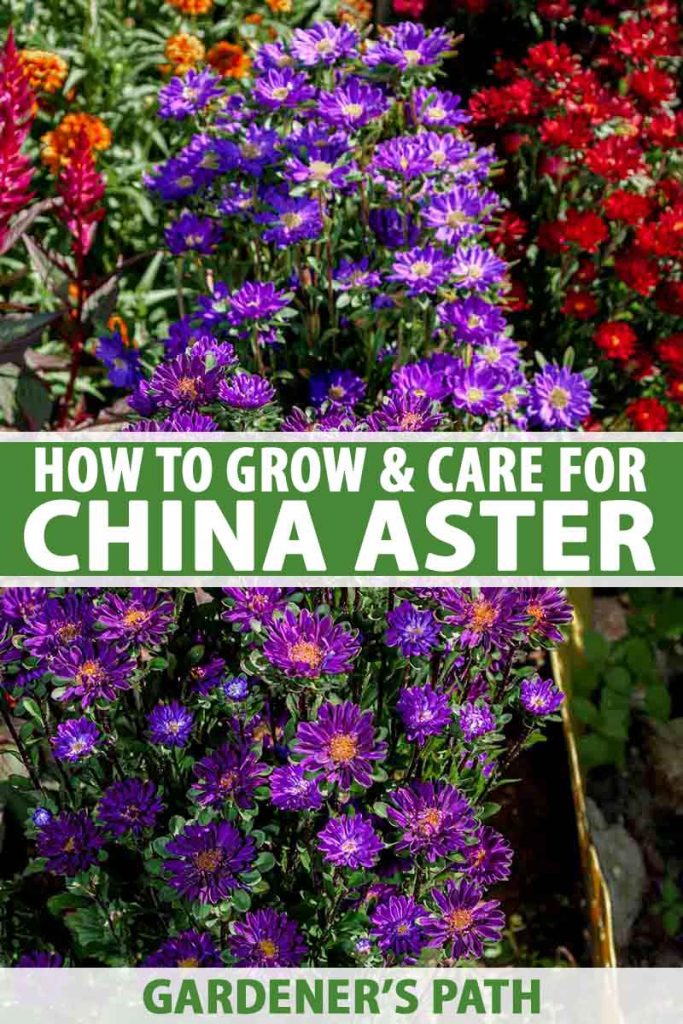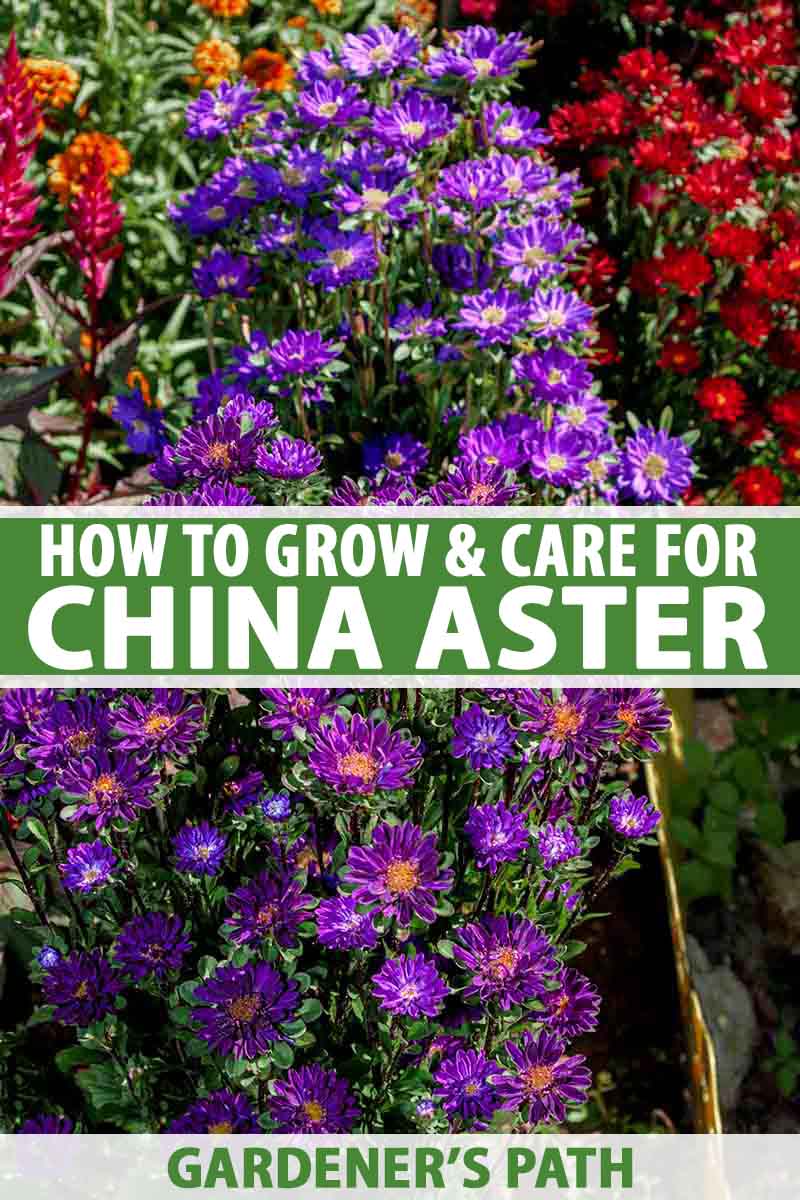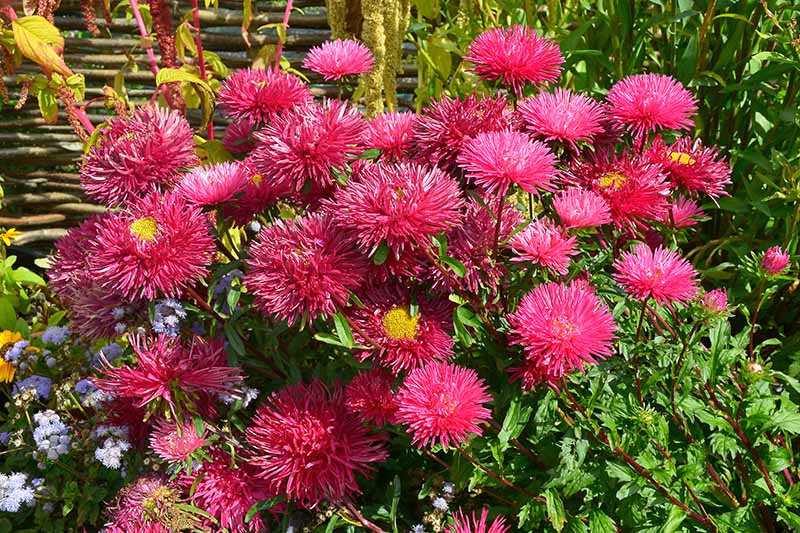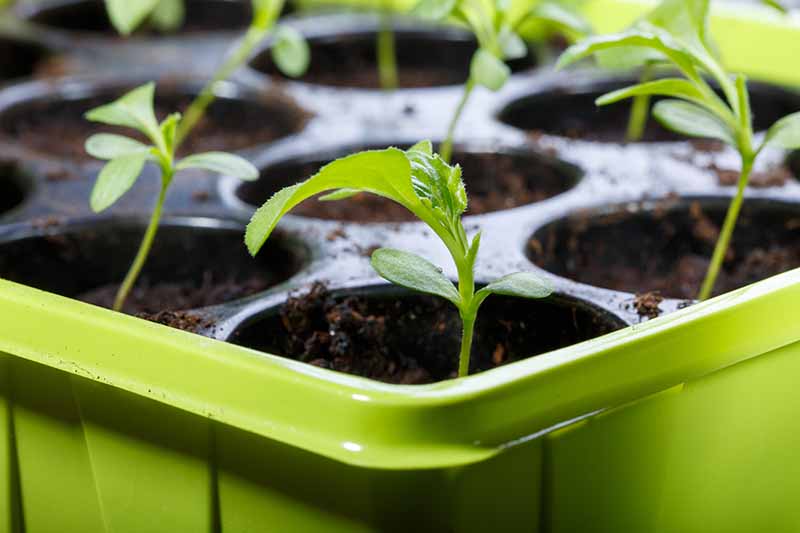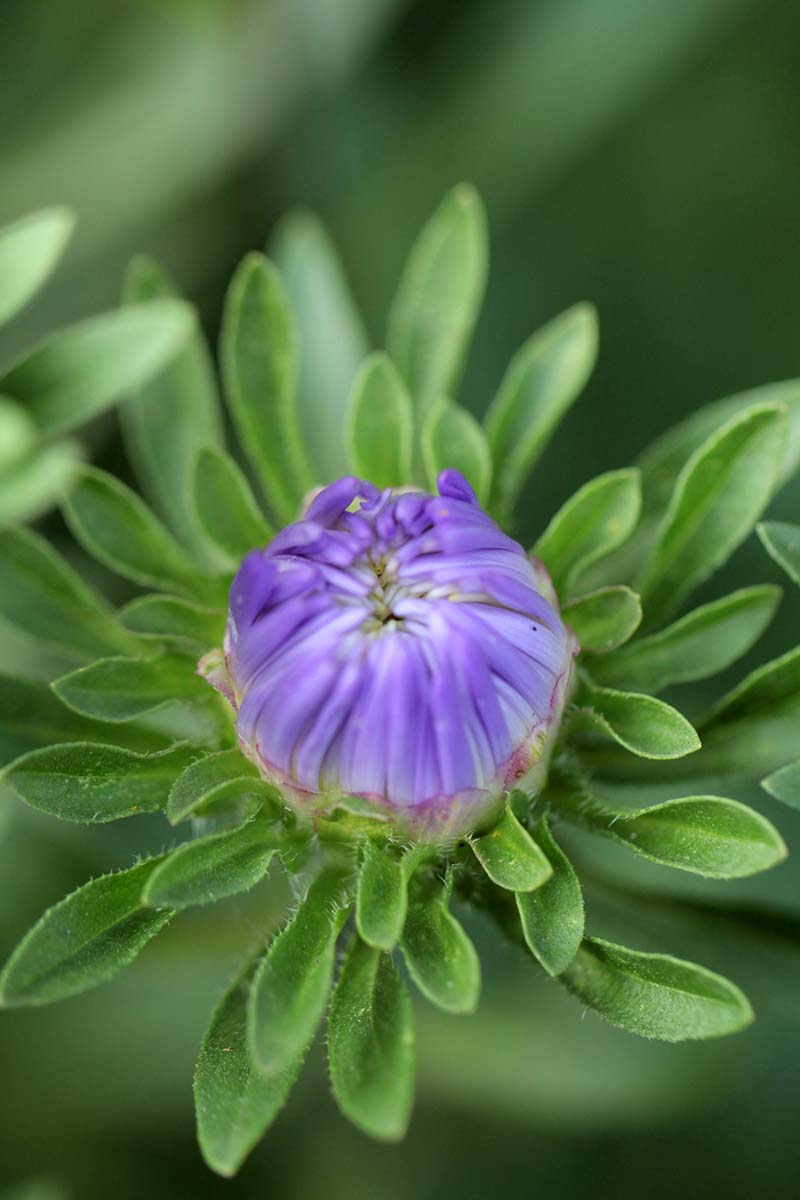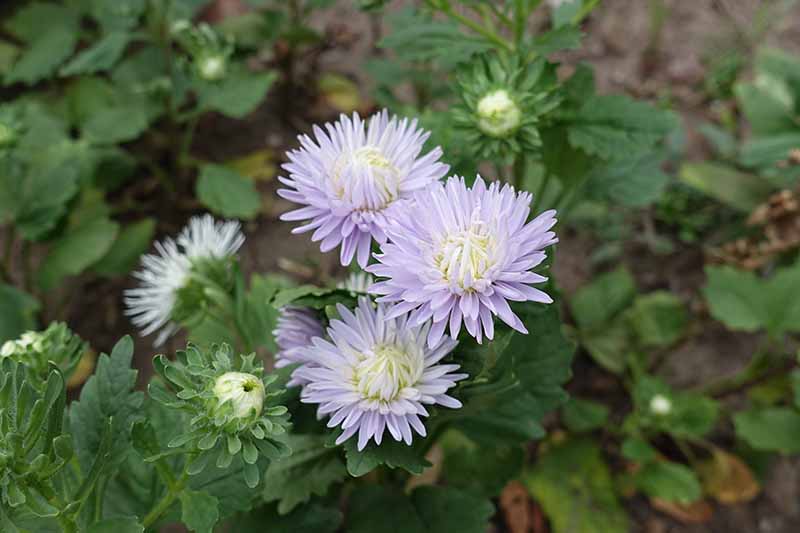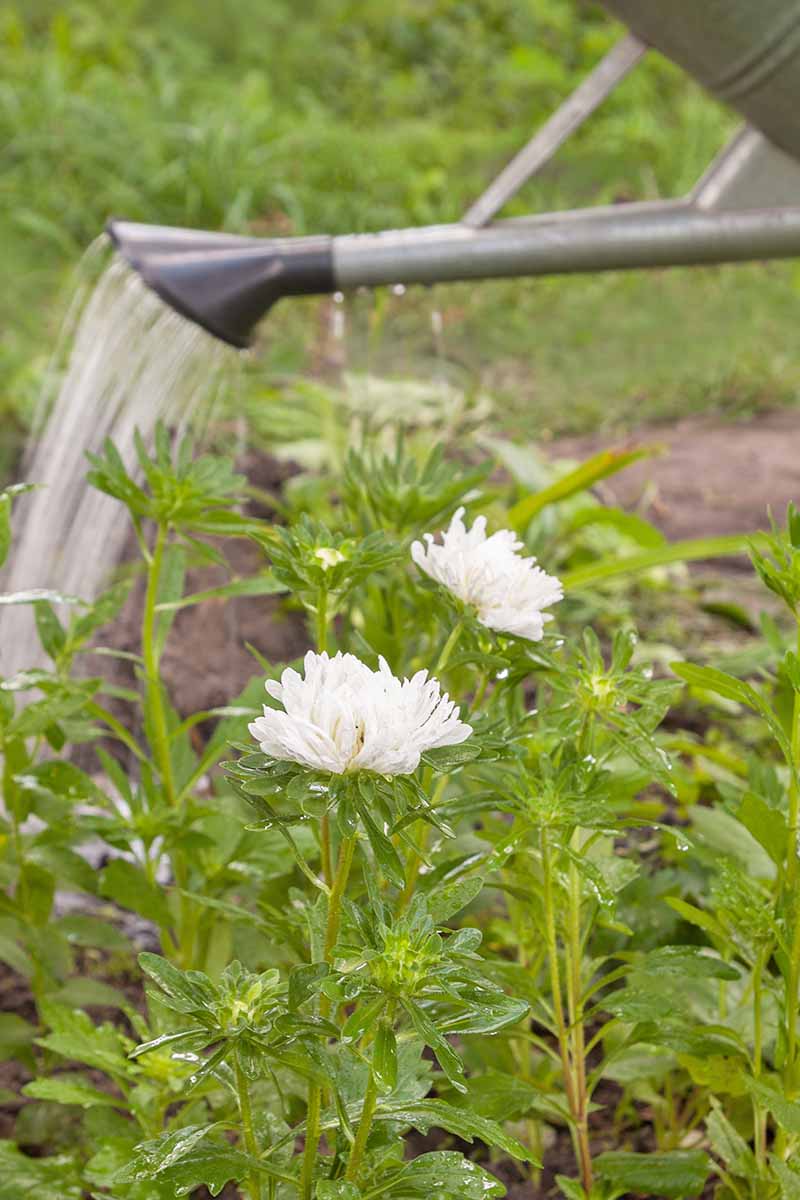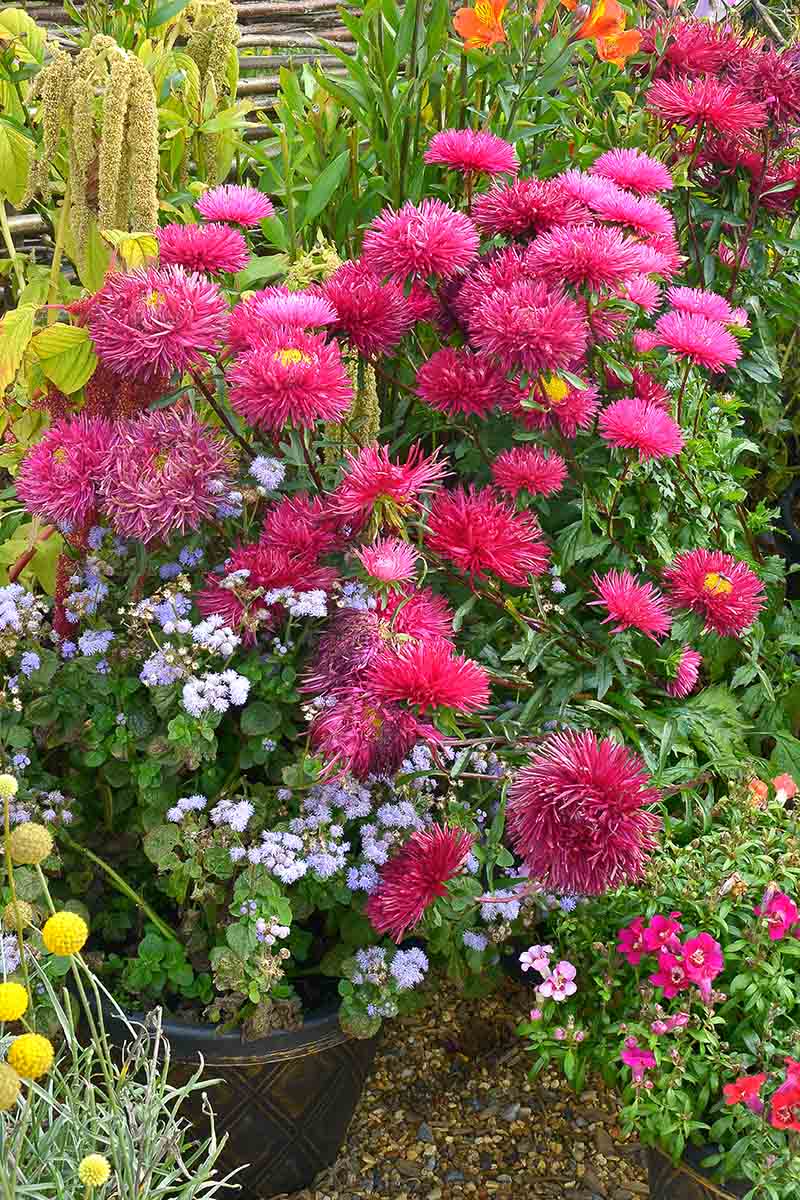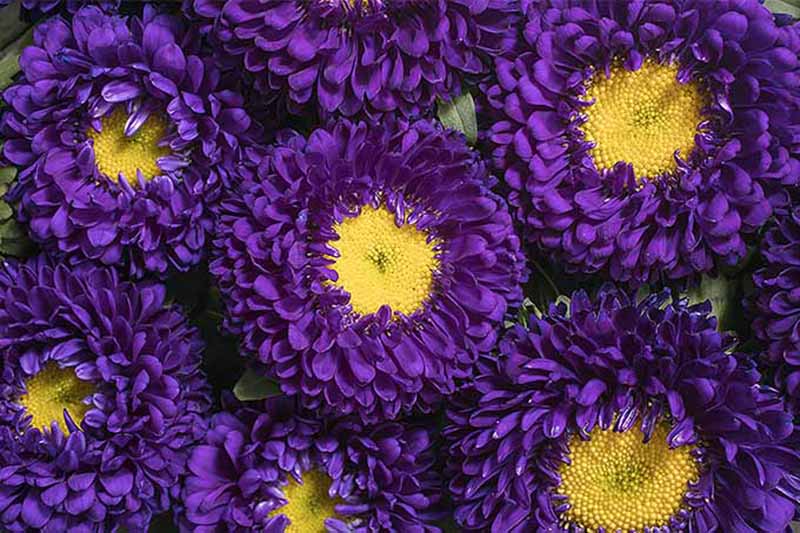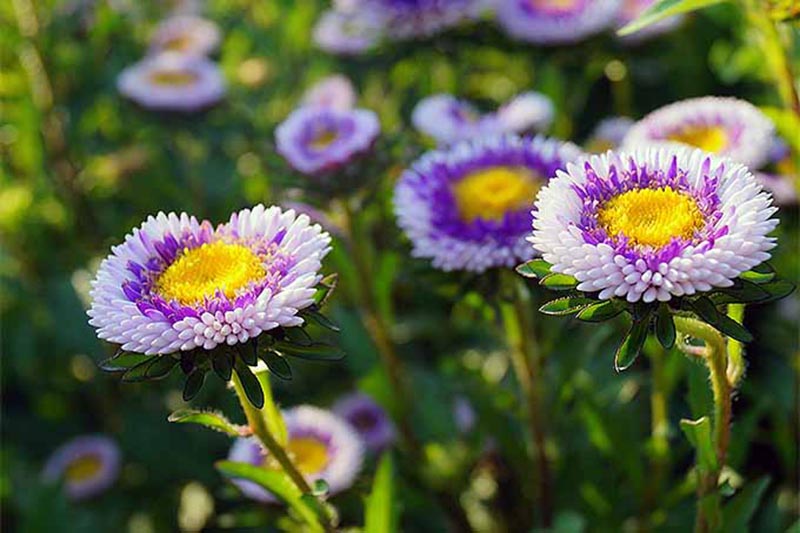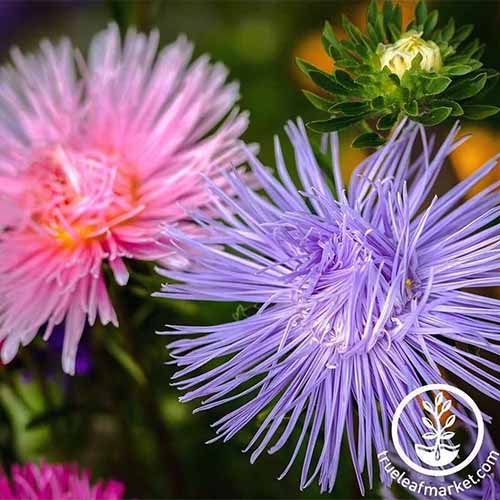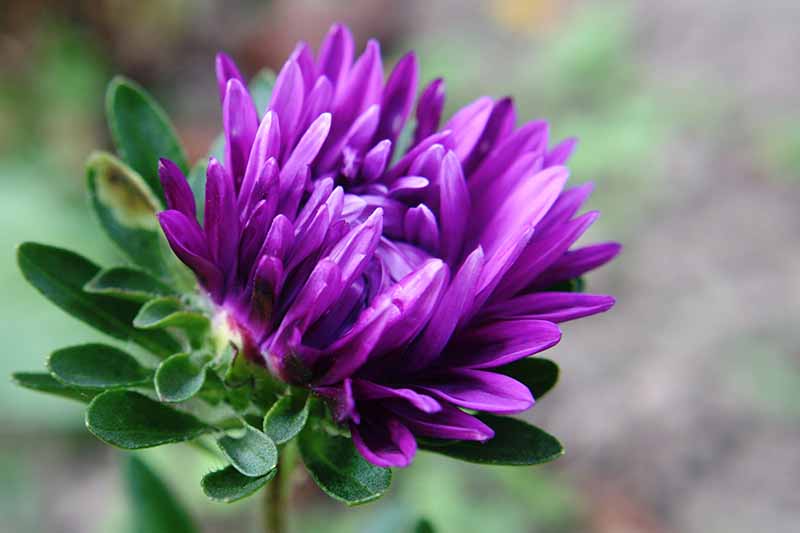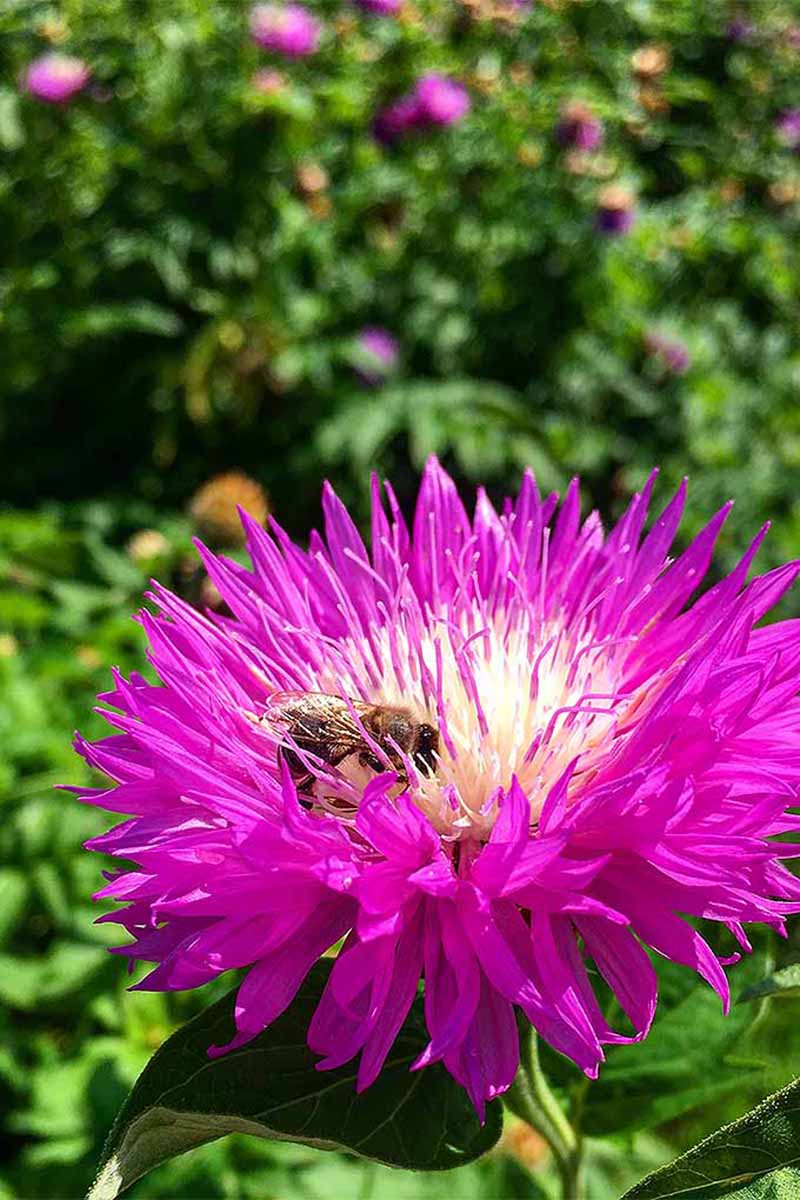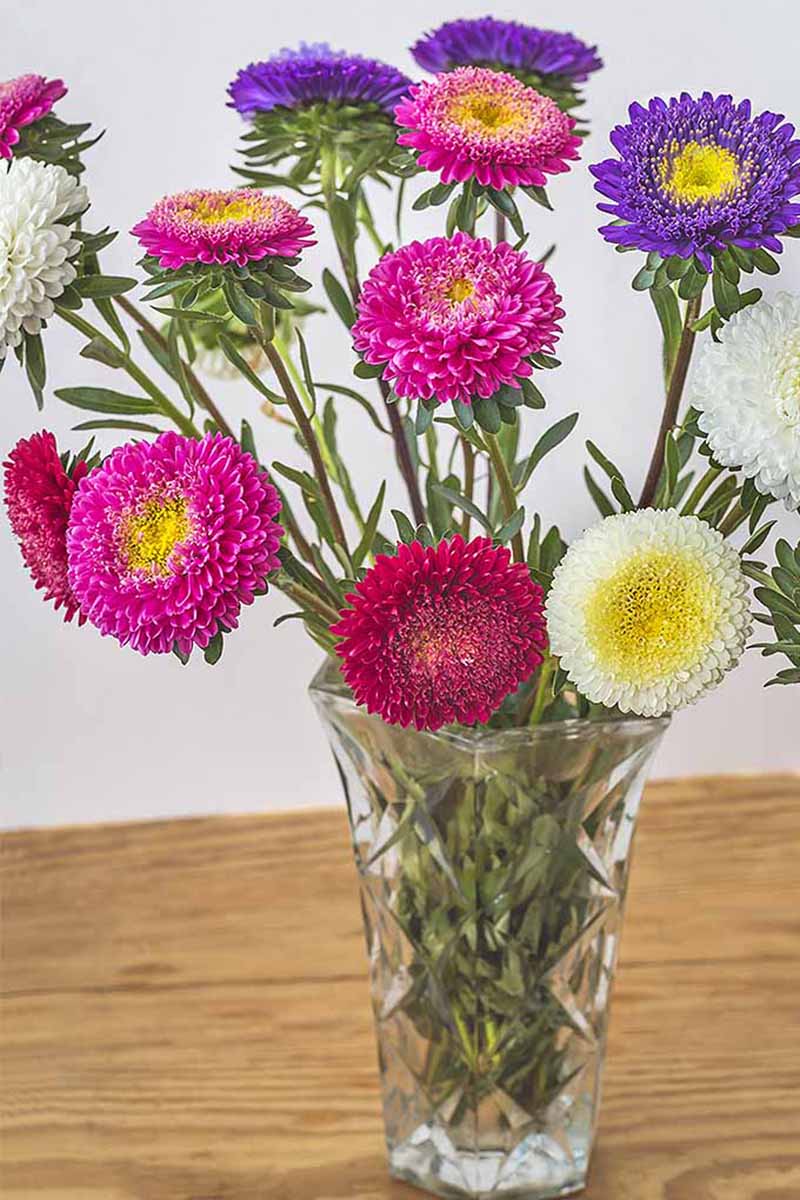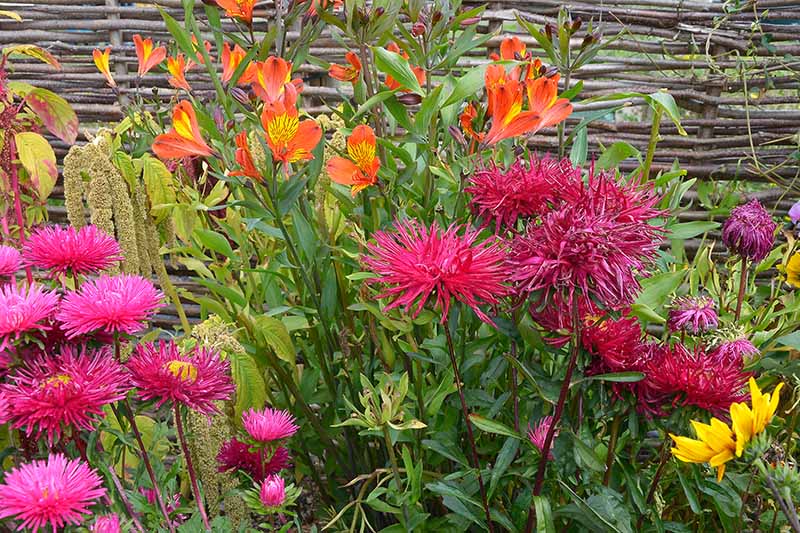Unlike other aster varieties, this particular species is not a perennial, but an annual. Bloom time is from late summer into fall, when it fills gardens and containers with cheerful flowers in vibrant tones. We link to vendors to help you find relevant products. If you buy from one of our links, we may earn a commission.
Cultivation and History
As an annual, C. chinensis is suitable for USDA Hardiness Zones 2 to 11. It grows vigorously in moist, well-drained soil in locations with full sun to partial shade. Stems are sturdy and can reach up to three feet tall at maturity.
Cultivars are available in a dazzling array of colors, including white, yellow, red, purple, pink, and blue, with a bright yellow center disc. Flowers are large, generally measuring between three and five inches across. They have single, full-double, or semi-double rows of petals. Each flower grows on a separate stem, unlike the clustered blooms of native aster varieties. Originating in the temperate regions of China and Korea, this species has undergone much horticultural manipulation to achieve today’s expansive range of cultivars. In the mid-1980s, a hybrid breeding program began in India, where C. chinensis has since become an important commercial crop. In addition to an increased color palette and more petals, today’s versions of the original species are wilt-resistant, with sturdy stems and alternating green leaves. They make for attractive and long-lasting cut flower arrangements.
Propagation
Also known as summer aster, C. chinensis is easy to propagate from seed. You can start seeds indoors six to eight weeks prior to the last average frost date for your region.
Keep the soil evenly moist, and ideally at a temperature of 70 to 72°F. Seeds should germinate in approximately 14 days. When the seedlings produce their first set of true leaves, you can transplant into pots, ready for hardening off and planting out. Gradually introduce seedlings to the conditions outdoors by placing them on a patio or sheltered location, after all risk of frost has passed. They will then be ready to transplant into the garden. Alternatively, you can sow seed directly outdoors after all danger of frost has passed.
How to Grow
C. chinensis can thrive in almost any soil, provided it is well-draining and is kept evenly moist. However, this plant prefers soil that is rich in organic matter, best achieved by the addition of aged manure, compost, or leaf mulch.
Before adding any amendments, it’s recommended that you do a soil test through the extension of a local land grant university, as additions to soil can alter its acidity. The ideal pH for growing China aster is between 5.5 and 7.5, a fairly wide range. Choose a location that gets full sun. While this plant tolerates part shade, it does best with lots of light. Be sure to provide room for the plant’s growth pattern. Mature heights range from 8- to 36-inches tall, with a spread of 12- to 18-inches wide.
Ideally, space plants nine to 12 inches apart, to accommodate mature dimensions and provide adequate air space between them. Providing adequate air space between plants lowers the risks of fungal infection and insect infestation. Once you have chosen an appropriate site that meets the needs of C. chinensis, it’s time to plant. Here’s how in 10 easy steps:
- Prepare a garden bed by digging down about six inches, turning the soil to break up clods until it is evenly crumbly. Amend with well-rotted compost if necessary.
- Moisten the soil with a garden hose or watering can so that it is saturated but not puddling.
- Sow seeds on top of the soil about three inches apart. Gently press each seed into the soil to a depth of approximately 1/8 inch. It is not necessary to cover them with soil.
- If you are planting nursery or homegrown seedlings, plant at the same depth as the root ball.
- Keep the soil evenly moist, never letting it completely dry out, but don’t allow it to become waterlogged.
- In two to three weeks seedlings will sprout. Continue to provide even moisture. Use floating row covers if desired to protect against pest and disease issues.
- When the seedlings have two to three sets of true leaves, start thinning them. Remove enough so that the remaining seedlings are spaced nine to 12 inches apart, depending on the variety you have chosen.
- Monitor water needs, and if there is no rain for a week, water thoroughly. The plants should never completely dry out. By providing even moisture, you can avoid stressing them which can make them vulnerable to pests and disease.
- Lightly cover the soil over around the plants with mulching material such as wood chips, shredded bark, or leaf mold to help the soil retain moisture as summer heats up.
- Fertilize with a well-balanced, slow-release, all-purpose granular fertilizer, such as NPK 10-10-10 throughout the growing season according to the package instructions. They generally take between 90 and 120 days to mature, depending on the variety you choose. Consult your seed packet information for details. For successive blooming, you can sow seeds every two weeks, depending upon the length of your growing season
Container Growing
China aster is a shallow-rooted plant that grows well in containers, provided it is never allowed to completely dry out. Use a pot that is about two inches wider than the mature dimensions specified on the seed packet, and at least 10 inches deep. Grown in containers, these flowers provide an attractive, colorful display in sunny spots on your patio or front porch.
Growing Tips
Space properly, according to mature dimensions, to provide adequate air circulation. Maintain even moisture, never letting the ground or pot completely dry out. Apply mulch to help the soil retain water during dry periods or in hot locations.
Care and Maintenance
Unlike native perennial asters, China aster is not self-sufficient once established, because it requires even moisture, in well-draining soil. Water deeply once a week, but do not allow the soil to become waterlogged.
You may fertilize with a well-balanced, slow-release granular fertilizer throughout the growing season according to the package instructions. Avoid those that are high in nitrogen, as this can encourage the plant to produce too much foliage and too few flowers. We’ve already mentioned adding a light layer of mulch as summer temperatures rise helps with moisture retention. Be sure to use it sparingly, as too much mulching material can create a damp environment and invite fungal growth. Also, be sure to keep the mulching material one to two inches away from the stem to prevent rot. Weed regularly to deter insects, inhibit fungal growth, and prevent competition for water and soil nutrients. To enjoy continuous blooming, deadhead regularly. This is the process of snipping off each spent bloom just above a leaf, to encourage another flower to grow in its place.
And finally, tall cultivars may require staking to keep them upright. I like to use bamboo garden stakes and twine to keep them from flopping over, especially after a heavy rain. However, the drawback of this approach is that bunching stems may restrict airflow and foster fungal infection in damp conditions. It prevents the stems from flopping and helps maintain good airflow. You can choose from a range of sizes and cut as needed.
Either leave the withering stems in place to provide wildlife habitat and winter interest, or cut them to the ground. As annuals, they will not return next year, so you will need to sow more seeds.
Cultivars to Select
When shopping for China asters for the garden, you are likely to find an abundance of options. They range from dwarf varieties with a petite stature of eight to 12 inches, to tall ones that top out at three feet. Cultivars vary by color, petal count, and height, so be sure to read all the details before making a purchase. Perhaps the best known to home gardeners are the double-flowered ‘Matsumoto’ cultivar, and the disc-like ‘Lilliput Blue Moon.’ There are also numerous hybrid “series,” including ‘Crego,’ ‘King Size,’ and ‘Valkyrie.’ These are all tall varieties that make a bold statement in the late season landscape.
Crego
The ‘Crego’ series offers 3- to 4-inch semi-double flowers with curled petals in bright pink, purple, red, or white.
’Crego Giant’ Mix The mixed batch of seeds is full of surprises, as you never know which of the colors will bloom next. Heights range from 18 to 36 inches, making this type an excellent choice for the back of garden beds and borders. Maturity is between 91 to 105 days. You can buy seeds in packets of various sizes from True Leaf Market.
Giants of California
‘Giants of California’ boasts two-and-a-half- to three-inch full- and semi-double flowers (extra petals) in shades of pink, purple, or white. Incurve petals resemble those of a chrysanthemum.
‘Giants of California’ With heights of 28 to 36 inches, it’s the perfect rejuvenation for the backs or beds and borders. This variety matures in 60 to 90 days. Find C. chinensis ‘Giants of California’ seeds available at Eden Brothers.
Valkyrie
The ‘Valkyrie’ series is known for its needle-like petals. Flowers in shades of pink, purple, red, white, and yellow are three to five inches across. This variety reaches a height of 24 to 36 inches, making it another fine candidate for areas where vertical interest is desired. Maturity is between 110 to 120 days. Want even more options? Be sure to check out our guide “13 of the Best Tall China Asters for the Late Summer Garden” to find the best choices for your landscape application.
Managing Pests and Disease
I always say the best defense against pests and disease is healthy plants. You can make great strides toward avoiding both if you do the following:
Start with quality seed. Provide adequate moisture. Space plants to promote airflow. Weed to inhibit insect infestation and maintain airflow. Fertilize with a well-balanced, all-purpose product per package instructions.
You may also apply food grade diatomaceous earth as a preventative measure. However, even with the best of intentions, sometimes issues arise. Perhaps there has been excess rainfall? Or not enough? Maybe the plants exceeded your expectations and are a bit crowded, reducing airflow? Asters that are stressed by factors such as these may become susceptible to pests such as:
Aphids Leafhoppers Spider mites
There are also diseases that may crop up, such as:
Aster yellows Botrytis blight Fusarium wilt Leaf spots Powdery mildew Rust Stem rot
Pest control is essential, as disease may be insect-borne. For example, leafhoppers may carry and spread aster yellows, an incurable infection that deforms and kills plants. If you notice such deformity, remove entire plants and dispose of them. Thankfully, this condition does not live on in the soil. Similarly, fusarium wilt may cause plants to lose vigor and fail for no apparent reason. If this issue presents itself, remove entire plants and do not plant susceptible species in this location next year, as this pathogen does live on in soil. It can be difficult to tell the difference, but you can collect plant tissue and soil and have them analyzed through your local land grant university extension. Insecticidal soaps and fungicides are available to treat other conditions as needed. All in all, your best bet is to be proactive and get off to a healthy start.
Best Uses
C. chinensis makes an eye-catching addition to beds and borders. Mix colors, or plant drifts of a single color to suit your own personal style. Add them to your cutting garden beside companionably tall zinnias.
If you’re a container gardener, you can’t go wrong. With its shallow roots, you have little fear of C. chinensis becoming pot bound. Remember that containers dry out quicker than the ground, and be vigilant about watering. Be sure to choose a well-draining pot that is at least 10 inches deep and about two inches wider than the plant’s mature dimensions. This will allow ample room for roots and airflow. It also makes it easy to get your watering nozzle close to the soil. Good choices for interplanting with annual aster plants are:
Alstroemeria Black-eyed Susan Coneflower Dahlia Garden phlox Montauk daisy Perennial asters Sunflower Zinnia
Asters may not bloom until late in the season, but the sturdy green foliage of C. chinensis provides a lush backdrop for other flowers that are in bloom, as well as providing a neutral filler between other ornamental specimens.
An Indoor Delight
China aster is not only pretty in the garden, it’s an excellent cutting flower for bringing indoors.
Here’s how:
- With clean, sharp pruning shears, cut the stems you want at a 45 degree angle.
- Remove the lower six to 12 inches of leaves.
- Place the stems in a vase of water, taking care to ensure that there are no leaves below the water line.
- Snip the stems on an angle and change the water daily. With this regimen, you can expect your cut flowers to brighten your home for up to two weeks.
Quick Reference Growing Guide
I used to try, halfheartedly, to keep my late summer garden going by snipping off the dead parts of my phlox and black-eyed Susans, and staking the half-dead stems. Now, with China aster planted among them, I simply cut the old flowers to the ground and get ready for China aster to take center stage. That first time summer asters lit up my up gardens with bold jewel tones, I fell in love, and I know you will, too. Choose your favorite cultivars today and start planning a summer-to-fall transition display that is sure to be the envy of the neighborhood! We enjoy our readers’ feedback. What grows in your late summer garden? Tell us in the comments section below! Want to learn more about growing asters? You will need these guides:
How to Grow Tatarian Aster: A Late Summer Bloomer How to Grow and Care for Early-Blooming Alpine Aster When and How to Save Native Perennial Aster Seeds 11 of the Best Pink Aster Varieties
© Ask the Experts, LLC. ALL RIGHTS RESERVED. See our TOS for more details. Originally published on September 18, 2017. [lastupdated]. Product photos via David’s Garden Seeds, Frozen Seed Capsules, and True Leaf Market. Uncredited photos: Shutterstock.
